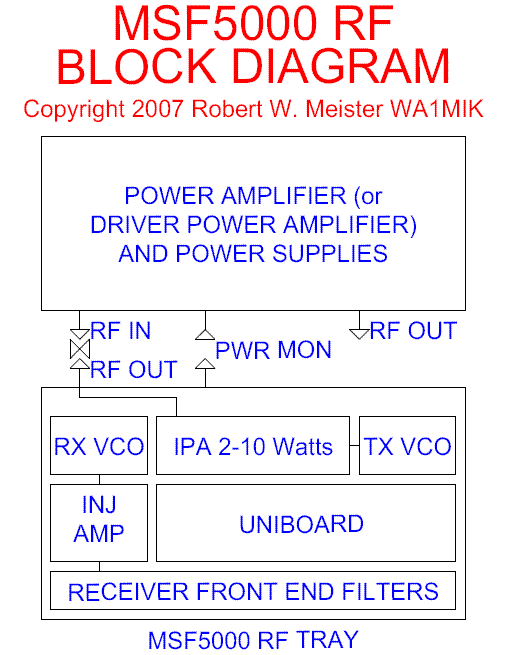Up two levels
Back to Home
MSF5000 Power Amplifier
By Robert W. Meister WA1MIK

|
Up one level Up two levels Back to Home |
Stand-Alone Use of the MSF5000 Power Amplifier By Robert W. Meister WA1MIK |

|
Enough people have asked how to do this, so here's the information you all want. The description and procedure herein pertains to ALL MSF5000 stations: VHF, UHF, 800 MHz, and 900 MHz.
DISCLAIMER: I have NOT done this myself, but other people have, and report that it works just fine as long as you follow certain precautions.
Station Configuration:
The MSF5000 stations generate transmit RF starting with the transmit VCO in the RF Tray. This +10dBm signal is doubled (in 800/900 MHz stations only) and amplified by an Intermediate Power Amplifier (IPA) that is capable of nearly 12 watts. On very low power stations, the IPA feeds a filter network that feeds the T/R relay (base stations) or the antenna (repeaters). For more power, the IPA feeds a Power Amplifier (PA) through either a barrel adapter (base stations) or a tuned filter (repeaters). The PA then feeds a filter and T/R relay (base stations) or a tuned filter (repeaters). On really high power stations (150-350 watts), the IPA feeds a Driver Power Amplifier (DPA) that makes some power (up to 25 watts for VHF, up to 50 watts for 800/900 MHz), and this feeds the Final Power Amplifier (FPA). The PA or FPA output is filtered and feeds the T/R relay or antenna as necessary. There is one Power Supply (PS) for the PA and VHF DPA, and an additional PS for the 800/900 MHz DPA, if present. Save yourself some trouble: use the power supply that came with the amplifier. The VHF PAs run on 28 volts DC; all other PAs and DPAs run on 14 volts DC. All RF input and output impedances are 50 ohms.
On VHF stations, the 25w DPA drives the 350 watt FPA. UHF stations use a 50w DPA to drive a separate FPA for power levels over 125 watts.
The IPA output power level is controlled by circuitry in the RF tray. Typical output power is 2-4 watts when feeding a PA or DPA.
The output filter (low-power stations) and the PA have thermistors in them that sense the temperature of the heat sink and the dummy load in the circulator (on those stations that have them). A sample of the RF output signal is also rectified and provides a DC voltage indication of forward power. All of these signals leave the PA (and DPA) via Molex connectors that end at the RF tray. If the temperature of the heat sink or dummy load rises, the IPA output power is reduced. If the forward voltage (output of the PA) varies, the IPA output power is adjusted as needed to maintain a constant output power. These signals are generated in the PA and DPA and are only necessary for the proper operation of these modules when they're used as part of an MSF5000 station.
The RF tray power control logic will not generate RF without some feedback from the PA. If you're not going to use the RF tray, you don't need to worry about the Molex connector and its signals. A very simplified block diagram of the major assemblies is shown below:

Using the PA:
To use the PA (and DPA if present) stand-alone, unplug the Molex connectors coming from the PA (and DPA) and turn the RF tray's output power potentiometer fully counter-clockwise (for safety incase the station decides to transmit).
Disconnect the input (male N) connector that feeds the PA (or DPA if present), and connect the output of your transmitter or exciter to this coax using the appropriate adapters. The PA or DPA only requires 2-4 watts of drive power, and you probably won't get any output below 2 watts of drive. This may vary slightly depending on the PA and band in use.You'll want to use a transmitter or exciter that allows you to finely control the output power in this range. With a wattmeter and dummy load attached to the PA output, set the output power of the transmitter or exciter to zero then key it up and increase the drive power until you reach rated output for that PA. That's it. The output power is not a linear function of the input power. For example, a 110w PA that makes 100 watts with 4 watts of drive may make only 20 watts with 3 watts of drive, and it may not make any power with 2 watts of drive. That's why the MSF5000 uses a high-gain power control circuit that depends on feedback from the PA to control the IPA.
You don't need to connect anything to the Molex connector. The signals it carries are outputs from the PA and are used only by the RF tray. Just provide plenty of A+ and the right amount of RF.
Motorola M1225 and MaxTrac mobile radios make good exciters, but you may have to add a manual power control potentiometer to the MaxTrac since it doesn't like being set too low. There is information on doing this in the Motorola MaxTrac section of this web site
Acknowledgements and Credits:
Thanks to Scott KBØNLY for suggesting several additions to this article. He has performed this procedure successfully on more than one occasion.
Contact Information:
The author can be contacted at: his-callsign [ at ] comcast [ dot ] net.
Up one level (MSF index)
Up two levels (Moto index)
Back to Home
This article first posted 01-Sep-2007
This web page, this web site, the information presented in and on its pages and in these modifications and conversions is © Copyrighted 1995 and (date of last update) by Kevin Custer W3KKC and multiple originating authors. All Rights Reserved, including that of paper and web publication elsewhere.